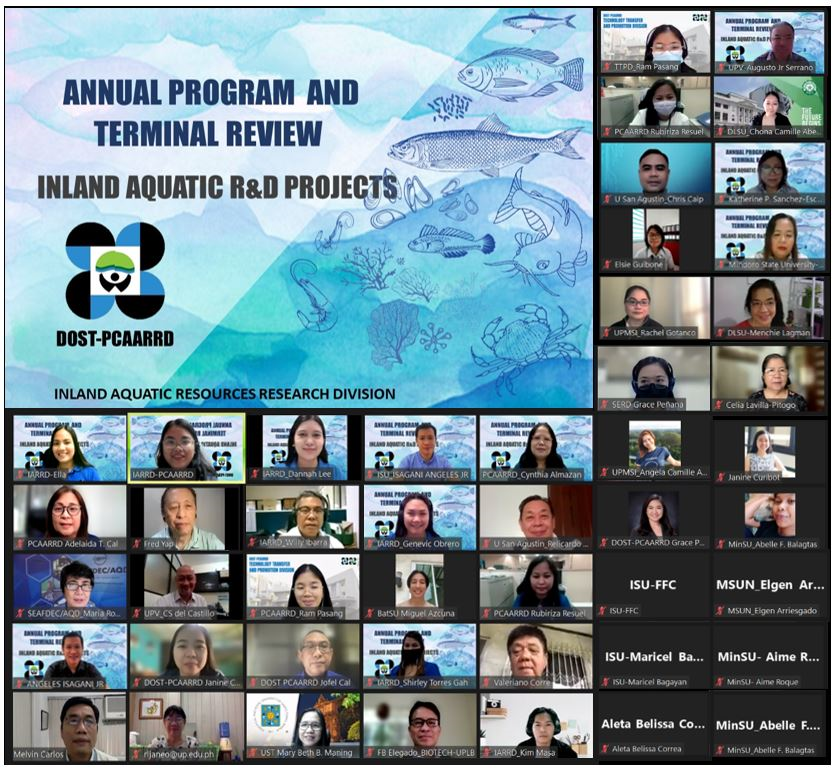
Inland aquatic R&D projects from seven commodities (shrimp, mangrove crab, tilapia, milkfish, mussel, aquafeeds, and inland aquatic biodiversity) share notable accomplishments through the Annual Program and Terminal Review on December 13-15, 2021 via video conference.
A total of 34 projects, broken down into 28 ongoing and 6 completed projects, were presented and reviewed. Among the accomplishments presented include the application of melatonin to induce molting in soft-shell mangrove crab, wherein immersion is the best mode of metabolite delivery for Scylla spp. crablets.
For the Shrimp Industry Strategic S&T Program (ISP), loop-mediated Isothermal Amplification (LAMP) detection kits for Acute Hepatopancreatic Necrosis Disease (AHPND) in shrimps were turned over to nine adopters in Luzon and Visayas. For milkfish, protocol for standard transport was developed and nursery practices were improved. Trainings were also conducted for milkfish operators and technicians in Davao region.
Moreover, the Backyard Tilapia Farming initiative had produced 2,193 kg of fish from underutilized fishponds in Laguna and Batangas areas. This resulted in an additional income of tilapia operators and an increase in their awareness and technical skills in tilapia pond production and processing. A meal diet with Padina extract was also formulated to enhance the growth performance of Nile Tilapia. The developed meals also had traceable amounts of phytochemicals that have potential antimicrobial and antifungal properties.
For freshwater eels, a diet was formulated with azolla and kangkong extracts, which contributed to better growth performance and improvement in immune response and disease resistance against A. hydrophila infection.
After each project presentation, questions and recommendations were raised by the evaluators and participants. The Technical Review and Evaluation Panel (TREP) was composed of Mr. Wilfredo G. Yap, Executive Director of SANTEH S&T Foundation, Inc.; Dr. Ma. Rowena R. Eguia, Scientist from SEAFDEC-AQ; Dr. Francisco B. Elegado, Scientist from the National Institute of Molecular Biology and Biotechnology (BIOTECH, UPLB); Dr. Relicardo M. Coloso, Professor at the University of San Agustin (USA), and Dr. Celia L. Pitogo, Fish Health Consultant of Feedmix Specialist, Inc.
A total of 55 participants from different universities and agencies, evaluators, and DOST-PCAARRD officials and staff attended the review. Presenters were from Isabela State University (ISU), University of San Carlos (USC), Northern Iloilo Polytechnic State College (NIPSC), Marinduque State College (MSC), Mindoro State University (MinSU), University of Sto. Tomas (UST), University of San Agustin (USA), Laguna State Polytechnic University (LSPU), University of the Philippines Visayas (UPV), University of the Philippines Diliman (UPD), Mindanao State University (MSU) – Naawan and Marawi Campuses, Batangas State University (BatSU), De La Salle University (DLSU), Central Luzon State University (CLSU), Western Philippines University (WPU), DOST 1 PSTC, and DOST-ITDI.
The activity was conducted by the Inland Aquatic Resources Research Division (IARRD) of the Philippine Council for Agriculture, Aquatic and Natural Resources Research and Development of the Department of Science and Technology (DOST-PCAARRD), headed by Officer-in-Charge, Dr. Adelaida T. Calpe. The review aimed to determine the project accomplishments based on target deliverables, identify technologies that are ready for transfer and commercialization and information for dissemination, and to ensure that the results of the projects are utilized by the beneficiaries. New researchable areas and research gaps were also identified, and areas for capacity building and policy analysis were defined.
DOST-PCAARRD officials, headed by Dr. Reynaldo V. Ebora, Executive Director; Dr. Feliciano G. Calora, Jr., Deputy Executive Director for R&D; and Dr. Melvin B. Carlos, Deputy Executive Director for Administration, Resource Management, and Support Services (ARMSS), welcomed the participants and evaluators. They are hoping that the exerted efforts of the researchers and their outputs become more relevant to the end-users, increase their productivity, as well as improve their way of life. They also anticipated that the results of the review will further develop the inland aquatic ISPs.
